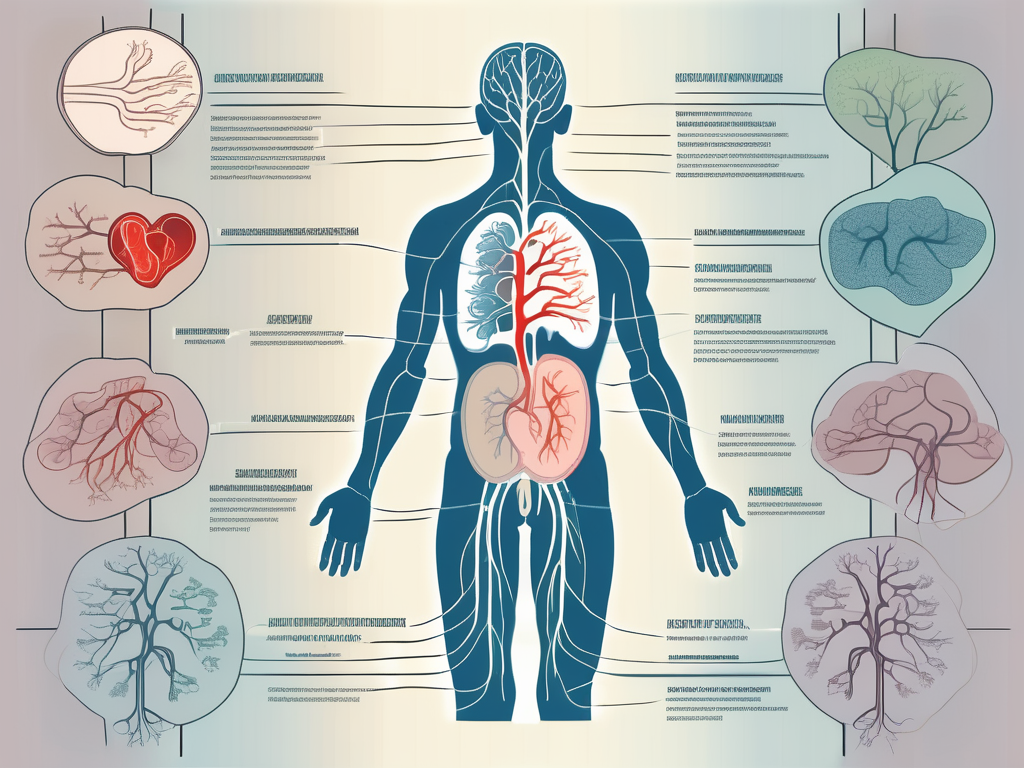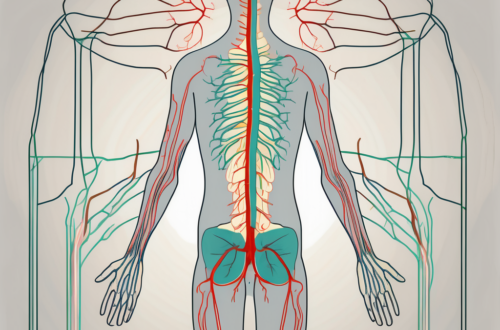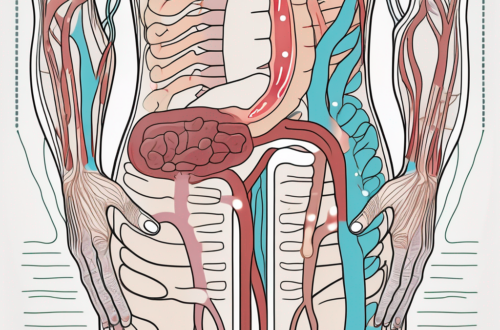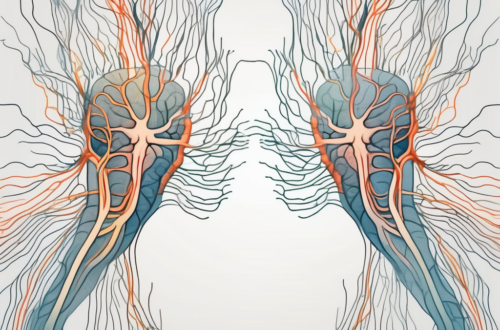The human body is a complex and fascinating system, and one of its most intricate networks is the nervous system. Comprising the central nervous system (CNS) and the peripheral nervous system (PNS), this system plays a vital role in enabling communication between the brain and the rest of the body. Within the PNS, the parasympathetic nerve tract is a critical component that regulates various bodily functions. Understanding the functions and implications of this pathway is essential for gaining deeper insights into human physiology and potential medical interventions.
Understanding the Nervous System
To begin our exploration, let’s briefly review the nervous system. It is a complex network of cells and tissues that allows for communication and coordination throughout the body. The nervous system is divided into two subsystems: the central nervous system (CNS) and the peripheral nervous system (PNS).
The CNS consists of the brain and spinal cord, which are responsible for processing and interpreting information. It acts as the control center of the body, receiving signals from sensory receptors and sending out instructions to various parts of the body.
The PNS, on the other hand, consists of nerves and ganglia outside the CNS. It serves as a communication highway, transmitting signals between the CNS and the rest of the body. The PNS can be further divided into two branches: the sympathetic nervous system and the parasympathetic nervous system.
The Role of the Parasympathetic Nerve Tract
The parasympathetic nerve tract plays a crucial role in maintaining the body’s overall balance and well-being. When activated, it promotes relaxation, conserves energy, and allows for essential bodily processes such as digestion and elimination. It counterbalances the effects of the sympathetic nervous system, which is responsible for the fight or flight response.
One of the key functions of the parasympathetic nervous system is to slow down the heart rate and decrease blood pressure. This helps the body conserve energy and promotes a state of calm and relaxation. Additionally, the parasympathetic system stimulates the production of digestive enzymes and increases blood flow to the digestive organs, facilitating the process of digestion.
The Sympathetic vs Parasympathetic Nervous System
It is worth understanding the differences between the sympathetic and parasympathetic nervous systems to appreciate the intricate balance that exists within our bodies. While the sympathetic system prepares the body for action in response to perceived threats or stressors, the parasympathetic system brings about a state of calm and restoration.
When the sympathetic nervous system is activated, it triggers a series of physiological responses known as the fight or flight response. This response prepares the body to either confront the threat or flee from it. It increases heart rate, dilates the airways, and redirects blood flow to the muscles, enabling the body to respond quickly and effectively.
In contrast, the parasympathetic nervous system promotes a state of rest and recovery. It helps to conserve energy and restore the body to a state of equilibrium after the threat has passed. The parasympathetic system slows down heart rate, constricts the airways, and directs blood flow to the digestive organs, facilitating digestion and promoting relaxation.
Overall, the sympathetic and parasympathetic nervous systems work together to maintain homeostasis, ensuring that the body can respond appropriately to different situations. This delicate balance between the two systems is essential for our overall health and well-being.
Delving into the Functions of the Parasympathetic Nerve Tract
Rest and Digest: The Parasympathetic Response
A primary function of the parasympathetic nerve tract is to initiate the rest and digest response. When activated, it slows down heart rate, promotes digestion, and enhances nutrient uptake. This state allows the body to repair, replenish, and recover from daily wear and tear.
During the rest and digest response, the parasympathetic system stimulates the release of digestive enzymes and increases blood flow to the gastrointestinal tract. This promotes efficient digestion and absorption of nutrients from the food we consume. It also helps to relax the smooth muscles of the digestive system, allowing for smooth movement of food through the digestive tract.
Furthermore, the parasympathetic response promotes the release of saliva, which contains important enzymes that aid in the initial breakdown of food. This ensures that the digestive process starts off on the right foot, setting the stage for optimal nutrient absorption.
While the rest and digest response is essential for overall health and well-being, it is important to note that chronic activation of the parasympathetic system can have negative consequences. Prolonged periods of rest and digestion can lead to weight gain, decreased physical activity, and a reduced metabolic rate. Therefore, maintaining a balance between the parasympathetic and sympathetic systems is crucial for optimal physiological functioning.
The Parasympathetic Influence on Heart Rate
The parasympathetic system plays a crucial role in regulating heart rate. It counteracts the sympathetic response, which increases heart rate during times of stress or physical exertion. By slowing down the heart rate, the parasympathetic response provides a necessary balance that helps maintain a healthy cardiovascular system.
When the parasympathetic system is activated, it releases the neurotransmitter acetylcholine, which binds to receptors in the heart. This binding leads to a decrease in the heart’s electrical activity and a subsequent decrease in heart rate. The parasympathetic influence on heart rate is particularly evident during periods of relaxation and rest, when the body does not require an elevated heart rate to meet increased demands.
In addition to regulating heart rate, the parasympathetic system also helps to maintain a steady rhythm and prevent arrhythmias. It achieves this by modulating the electrical signals that control the contraction of the heart muscles. This precise control ensures that the heart beats in a coordinated and efficient manner, optimizing its ability to pump blood throughout the body.
The Role in Pupil Constriction
Pupil constriction, also known as miosis, is another function regulated by the parasympathetic nerve tract. When exposed to bright light, the parasympathetic system triggers the contraction of the circular muscles surrounding the iris, resulting in smaller pupil size. This mechanism protects the delicate structures of the eye from excessive light exposure, ensuring optimal visual function.
By constricting the pupils, the parasympathetic system reduces the amount of light entering the eye. This helps to prevent overstimulation of the retina and protects the sensitive photoreceptor cells from potential damage. Additionally, pupil constriction enhances depth of field and improves visual acuity, allowing for better focus on nearby objects.
Conversely, when the parasympathetic system is inhibited, such as in low light conditions, the pupils dilate to allow more light to enter the eye. This dilation, known as mydriasis, helps to maximize the amount of available light for optimal vision in dimly lit environments.
In summary, the parasympathetic nerve tract plays a vital role in maintaining various physiological functions. From promoting rest and digestion to regulating heart rate and controlling pupil size, this intricate system ensures the body operates harmoniously, allowing us to navigate the world around us with ease and efficiency.
Implications of Parasympathetic Activity
The parasympathetic system, also known as the “rest and digest” system, is responsible for promoting relaxation and maintaining homeostasis in the body. It works in opposition to the sympathetic nervous system, which is responsible for the “fight or flight” response. Understanding the implications of parasympathetic activity can provide valuable insights into stress management, digestive health, and sleep quality.
Parasympathetic Nerve Tract and Stress Management
In today’s fast-paced world, managing stress is of utmost importance for overall well-being. The parasympathetic system can play a pivotal role in stress reduction. By activating the parasympathetic response through relaxation techniques such as deep breathing, meditation, or yoga, individuals can counterbalance the effects of chronic stress on their bodies. The parasympathetic nerve tract, consisting of cranial nerves and sacral nerves, innervates various organs and tissues, promoting a state of calmness and relaxation. However, it is essential to remember that chronic activation of the parasympathetic response can lead to excessive relaxation and diminished physiological responses, potentially impacting overall health. Consulting with a healthcare professional is advisable for personalized stress management strategies.
Impacts on Digestive Health
Optimal digestion is crucial for nutrient absorption and overall health. The parasympathetic system promotes enhanced blood flow to the digestive organs, stimulating the secretion of digestive enzymes and increasing intestinal motility. This enhanced activity helps to break down food efficiently and extract essential nutrients. The vagus nerve, a major component of the parasympathetic system, plays a significant role in regulating digestion by innervating the stomach, liver, pancreas, and intestines. However, disruptions in parasympathetic functioning can lead to digestive disturbances, such as irritable bowel syndrome or functional dyspepsia. These conditions can cause symptoms like abdominal pain, bloating, and altered bowel habits. Consulting with a healthcare professional can provide guidance on managing these conditions effectively, including lifestyle modifications, dietary changes, and potential medical interventions.
The Parasympathetic System and Sleep Quality
Good sleep is vital for physical and mental well-being. The parasympathetic system plays a crucial role in promoting relaxation and preparing the body for restorative sleep. By activating the parasympathetic response, individuals can experience improved sleep quality and wake up feeling refreshed. The release of neurotransmitters, such as acetylcholine, during parasympathetic activity helps to calm the mind and promote a state of relaxation conducive to sleep. The parasympathetic system also influences the regulation of circadian rhythms, the body’s internal clock that governs sleep-wake cycles. However, disruptions in the parasympathetic system, such as hyperactivity or dysregulation, can lead to sleep disturbances. These disturbances may manifest as difficulty falling asleep, frequent awakenings during the night, or non-restorative sleep. It is important to seek medical advice if experiencing ongoing sleep difficulties to identify and address underlying causes, which may include lifestyle factors, stress, or underlying medical conditions.
Disorders Related to the Parasympathetic Nerve Tract
The parasympathetic nervous system is an essential component of the autonomic nervous system, which regulates various bodily functions. Dysautonomia, a disorder that affects the autonomic nervous system, can disrupt the balance between the sympathetic and parasympathetic systems. This disruption can lead to a wide range of symptoms and complications.
Dysautonomia can manifest in different ways, affecting the regulation of heart rate, blood pressure, digestion, and other bodily functions. Individuals with dysautonomia may experience symptoms such as dizziness, lightheadedness, fatigue, gastrointestinal issues, and difficulty regulating body temperature. The severity of symptoms can vary from person to person, and personalized management approaches are often necessary.
Accurate diagnosis and appropriate treatment are crucial for individuals with dysautonomia. Consulting with a healthcare professional who specializes in autonomic disorders can help determine the underlying cause of the dysfunction and develop a comprehensive management plan. This may involve a combination of medication, lifestyle modifications, and targeted therapies.
Understanding Dysautonomia
Dysautonomia refers to a dysfunction of the autonomic nervous system, which includes both the sympathetic and parasympathetic systems. This disorder can manifest in various ways, affecting the regulation of heart rate, blood pressure, digestion, and other bodily functions. Symptoms can range from mild to severe and may require personalized management approaches. Consulting with a healthcare professional who specializes in autonomic disorders is crucial for accurate diagnosis and appropriate treatment.
There are several types of dysautonomia, including postural orthostatic tachycardia syndrome (POTS), neurocardiogenic syncope, and pure autonomic failure. Each type has its own set of symptoms and challenges, requiring individualized care. It is important to note that dysautonomia can be a primary disorder or secondary to other conditions such as diabetes, autoimmune diseases, or neurological disorders.
Diagnosing dysautonomia can be complex, as symptoms can overlap with other medical conditions. Healthcare professionals specializing in autonomic disorders often conduct a thorough evaluation, which may include a detailed medical history, physical examination, autonomic function tests, and sometimes additional diagnostic procedures.
Parasympathetic Hyperactivity and its Consequences
While the parasympathetic system is crucial for maintaining balance and promoting relaxation, excessive parasympathetic activity can have negative implications. Parasympathetic hyperactivity is associated with symptoms such as bradycardia (abnormally low heart rate), hypotension (low blood pressure), and impaired digestive function. These symptoms can significantly impact an individual’s quality of life and daily functioning.
Parasympathetic hyperactivity can be caused by various factors, including certain medications, underlying medical conditions, or even psychological stress. Identifying the underlying cause is essential for effective management. Healthcare professionals with expertise in autonomic disorders and related conditions can conduct a thorough evaluation to determine the specific factors contributing to parasympathetic hyperactivity.
Management of parasympathetic hyperactivity often involves a combination of approaches. Lifestyle modifications, such as stress reduction techniques, regular exercise, and a balanced diet, can help regulate the autonomic nervous system. Medications may also be prescribed to target specific symptoms or underlying conditions. It is important to work closely with a healthcare professional to develop an individualized treatment plan.
Treatment and Management of Parasympathetic Disorders
When it comes to managing parasympathetic disorders, a personalized approach is necessary. Treatment options may include medication, lifestyle modifications, and targeted therapies to address the underlying cause of the dysfunction. Consulting with a healthcare professional who specializes in autonomic disorders is essential for accurate diagnosis and comprehensive management.
In addition to medical interventions, individuals with parasympathetic disorders can benefit from self-care strategies. These may include stress management techniques, such as deep breathing exercises, meditation, and yoga. Engaging in regular physical activity, maintaining a healthy diet, and getting enough sleep can also support overall well-being and help manage symptoms.
It is important to note that the management of parasympathetic disorders is an ongoing process. Regular follow-up appointments with a healthcare professional are necessary to monitor symptoms, adjust treatment plans if needed, and address any new concerns that may arise. With proper care and support, individuals with parasympathetic disorders can lead fulfilling lives and effectively manage their condition.
Future Research Directions in Parasympathetic Nervous System
Potential Therapeutic Targets
As research in the field of neurology and physiology progresses, potential therapeutic targets related to the parasympathetic nervous system are being explored. Scientists are investigating novel approaches to modulate the parasympathetic response to manage various conditions, including cardiovascular disorders, digestive disturbances, and sleep disorders. These future developments hold promise for advancing medical interventions and improving patient outcomes. However, it is important to remember that these advancements are still at the research stage, and consulting with healthcare professionals is crucial for evidence-based treatments.
The Parasympathetic Nervous System and Aging
Aging affects various bodily systems, including the parasympathetic nervous system. As we age, there may be changes in parasympathetic functioning, which can impact cardiovascular health, digestion, and sleep quality. Further research is needed to gain a comprehensive understanding of these age-related changes and develop effective strategies to support healthy aging. Regular health check-ups and consultations with healthcare professionals can help individuals navigate these changes and ensure optimal well-being in their golden years.
The Parasympathetic System and Mental Health
The interplay between the parasympathetic system and mental health is a fascinating area of research. Studies have shown that parasympathetic activity is associated with improved emotional regulation, reduced anxiety, and enhanced overall mental well-being. As our understanding of the complex connections between the nervous system and mental health deepens, there is hope for developing innovative interventions and treatments for mental health conditions. It is important to prioritize mental health and seek guidance from mental health professionals for appropriate diagnosis and management.
In conclusion, exploring the functions and implications of the parasympathetic nerve tract offers valuable insights into the intricate workings of the human body. From maintaining homeostasis to managing stress and influencing various bodily functions, the parasympathetic system plays a crucial role. However, disruptions in its functioning can lead to disorders and health issues. Understanding these intricacies and seeking professional guidance when necessary are essential for ensuring optimal health and well-being. As ongoing research expands our knowledge, the potential for targeted interventions offers hope for a future where parasympathetic health is optimized and human potential is unleashed.





